
About this time last year I helped my mother-in-law’s Kimjang at her house and in return, I brought home couple containers of her yummy Kimjang. This year, I decided that it was time I tried it all on my own. I was a bit worried that I may not be able to handle the large amount of ingredients but hey, you have to take risks in life, right?
In late September, after my potato harvest, we planted Korean cabbages (배추 Baechoo), radishes (무우 Moo), Korean leeks (대파 Daepa) and mustard greens(갓 kaat) at our family farm for Kimjang.
After about 2 months, they were ready for picking. These pictures were taken around 11/20 or so. I came home with 16 cabbages, 9 radishes and a huge bunch of mustard greens. Also about two large bunches of Korean leeks. I bought the rest from the market.
Because I basically used the same Kimjang kimchi recipe from last year I will not list it again here. However, I will write more in depth about prep work- especially brining/salting cabbages. I know I mentioned in my last year’s post how most people just buy already brined cabbages (절임 배추 jeorim baechoo) because people say that’s the most difficult part of Kimjang both in terms of complexity and effort. You can use these tips for pickling cabbages in making regular small batch Kimchi at home.
How to brine (pickle) Korean napa cabbage (배추 baechoo) for Kimchi:
Ingredients
- 5 KOREAN NAPA CABBAGES (about 6 lb/2.7 kg each)
- 12 Cups or 5 lb/2.3 kg coarse SEA SALT (bitterns removed)
- 70 Cups/16.5 litre/17.5 qt cold or lukewarm WATER
- 1 gallon size bowl
- 1 giant container or bathtub to hold cabbages while they are brined
- 1 giant strainer/colander to drain brined cabbages
Directions
- Clean cabbage – Clean and cut away any outer leaves that are too damaged, brown or dirty. Most likely, your local market will sell already cleaned cabbages in which case need to do nothing. **Make sure you leave some good greenish outer leaves so you can use it to wrap the kimchi at the end.
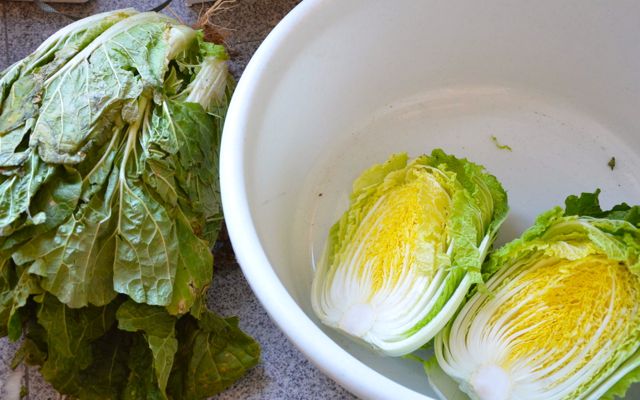
Cleaning cabbage for Kimjang kimchi Note how large the baechoo is on the left compared to the cleaned and cut ones on the right.
- Cut each cabbage in half. Tip for cutting cabbage for Kimchi: just cut about 1/3 of the bottom half (from the root end) and rip apart by hand. Like so –
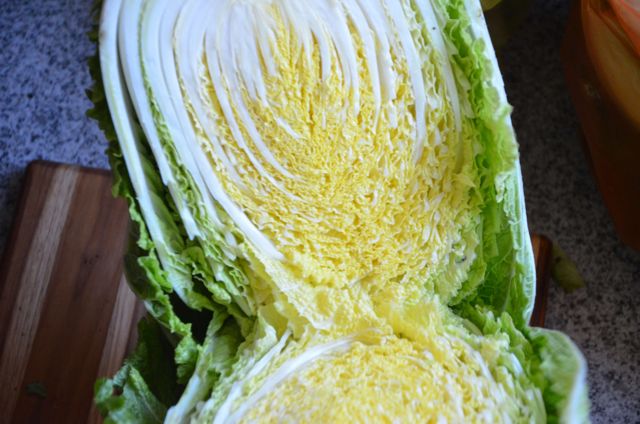
How to cut Kimjang cabbage baechoo in half It won’t be a huge disaster if you cut it all the way with a knife but it’s just easier this way and also you will not end up wasting cabbage pieces.
- In a large container, dissolve about 8 cups of salt and 17 1/2 quarts/70 Cups of cold or lukewarm water for the brine. Reserve remaining 4 cups salt for sprinkling. Please read my Kimjang tips post on discussion about salt. Solar sea salt is best if you can get them.
- Put cabbages in brine (made in step 3) – make sure the brine seeps fully into the cabbage by spreading out the leaves with your hands and swirling it around.
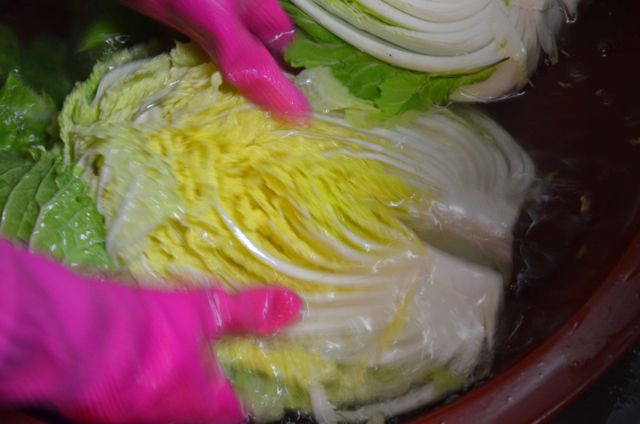
soaking cabbage in brine for Kimchi - Leave cabbages in brine for 2~3 hrs until the leaves start to get soft.
- When leaves are soft, For each 1/2 cabbage, REPEAT the following 3 steps:
-
- Take each cabbage out and let it drain for couple seconds and put in a bowl. DO NOT discard the brine because you will be putting cabbages back later on.
- Get a handful of salt from the remaining 4 cups and sprinkle (more like spraying) the salt in between leaves of each 1/2 cabbage, starting from the outer leaves. Aiming the salt mostly on the thick, white fleshy part of the cabbage.
- Put salted cabbages back into the brine.
-
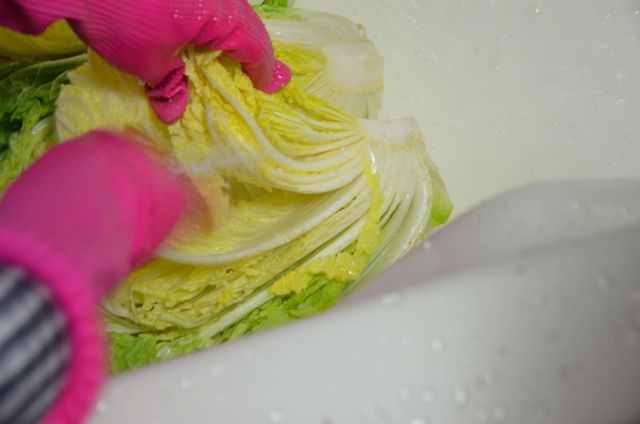
Salting cabbage for Kimchi ** We do this because the thick white fleshy part takes longer and more salt to pickle. You only need about 1/2 cup or less for each 1/2 cabbage. You may not need to do this if your cabbage has very thin white flesh or if you want to make your kimchi less salty.
7. Let cabbages sit in brine for another 10~12 hrs. Making sure cabbages are evenly pickled by rotating the ones on the top with the ones in the bottom, every 4 hrs or so.
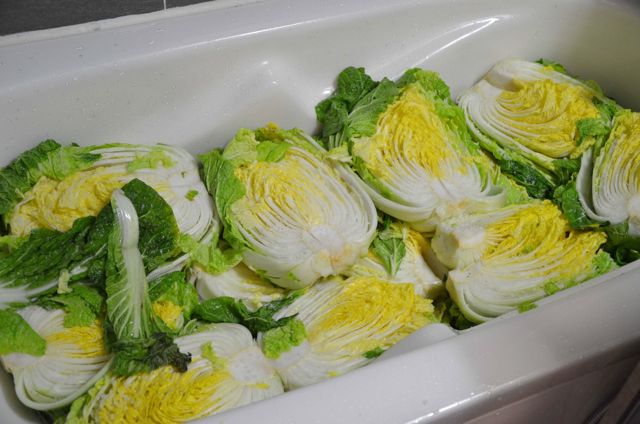
8. Next morning, the white part of the cabbage should be fully bendable like so-

9. Rinse cabbages 3 times thoroughly. Let cabbages drain for 1 hr or so. Place the cut side down when draining.
Now you are ready to make the seasoning and finish up the Kimchi!
For the list of ingredients and recipe – see my post Kimjang Day: Part 1 – How it’s done.
For more info on ingredients and other tips – see my post Kimjang Day: Part 2 – Ingredients and Tips
Some Kimchi recipes tell you to brine cabbages for 6-8 hrs (at room temp) and this can work well for smaller batches (in fact, that’s what I do in my Easy Blender Kimchi) but traditionally, Kimjang cabbages were pickled overnight in cold winter weather.
In my opinion, brining overnight works better simply in terms of scheduling because you can start brining cabbages at night time and then finish making Kimjang kimchi the next morning. If you brine them for only 6-8 hrs, then you either end up making Kimchi at wee hours of the night or you end up starting the pickling process after midnight. None of which is fun..
So in my case, I washed and cleaned all the vegetables first during the day and then started pickling the baechoo (cabbage) in our bathtub around 7pm. Which meant I could rinse it around 8 am next morning.
Well, now you have it! With my tips on how to pickle/brine Korean cabbages for Kimchi, you should be able to make a very delicious Kimchi anytime!
About the BRINE:
- Pickling in 15% salt solution is the traditional standard for Kimchi cabbages. A recent trend is to make it less salty and many Koreans now pickle at 10~12 % salt solution. e.g. If you want to make a 10 cup brine solution, you can mix 8 1/2 C of water and 1 1/2 C salt. This is not an exact formula for making 15% but that’s what many people use to make things simpler and quicker. In this level of salinity, you will only need to pickle the cabbages in 6-8 hrs.
- Interestingly, in some coastal areas, Koreans pickle their cabbages in sea water instead of making a brine. Note, sea water’s salinity is around 3.5% to 4% which is much lower salinity than our brine so you will need to leave the cabbages much longer – usually a full 24hrs or longer.
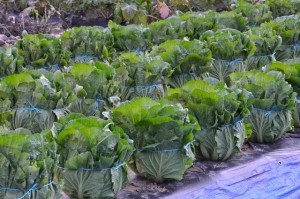
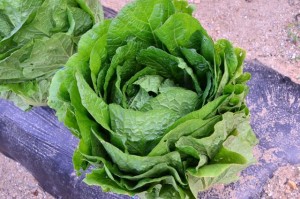
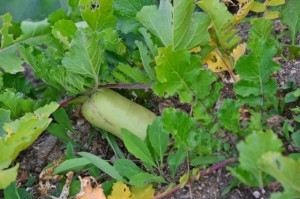
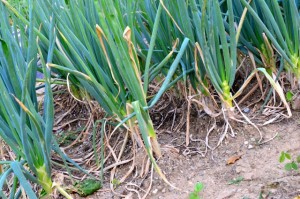

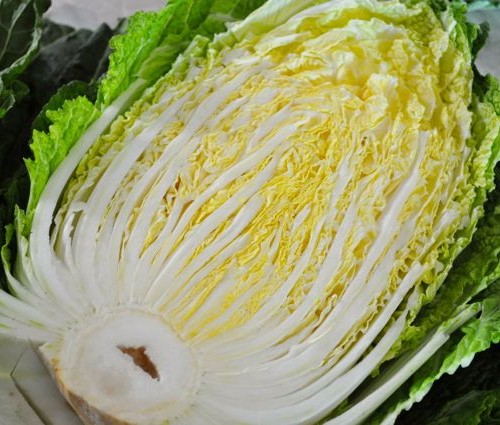


















Hello there,
I made my first kimchi today. I drained the cabbage as much as I can but since I used fish sauce for the paste, there is a bit of extra liquid for my kimchi. Should I drain that liquid? If not, what will happen? Will the liquid oveflow or become too salty? There is about half inch left in the bottle from the lid.
Extra liquid is good! It is best if cabbages stay wet under the liquid. Half inch sounds a bit tight. I think it may overflow. Try a bigger container or maybe take some kimchi out to leave more room at top. Good luck!!
Hello Jinjoo! Thanks for getting back to me, it did overflow a little, not too much but the good thing is that I wrapped the bottle with brown paper so that kinda helped me with the cleaning hehe. Now what I did after I cleaned up is I put a bowl below my jar haha in case it overflows. I hope it turns out really well but when I tried to taste it it wasn’t bad there’s a spicy kick but I can tell it wasnt fermented yet that time because I can tell the differences of the ingredients. Now I haven’t tasted it yet because it is still fermenting but I am crossing my fingers that it gets sour 🙂 thanks again and hopefully I am good with kimchi after this! 🙂
Jinjoo!!! Hello again just wanted to say that I tasted my Kimchi today and it was good!!! It already fermented perhaps because I live in a tropical country! Haha rarrr! Can I keep this kimchi for a couple of months? I am consuming this alone and I made 2 pounds actually hahaha 🙂
Hi!! Great news!! So happy that it tastes good. Yes, you can keep your Kimchi for couple months if you can keep it at low temperature – almost freezing temperature will keep it fresh the best. Normal fridge temperature may be a little too warm for long term storage and will sour the kimchi a bit too much if you keep it for 2 months. Hopefully you can find a way to keep it at lower temperature. Good luck!
Hi jinjoo, this is a very informative recipe. Thank you! You mentioned using sea salt and removing bitterns – what’s that and how do you do it?
I have some expensive sea salt from my korean mother-in-law. Should I use that or american sea salt?
Thank you.
Sorry for the late response – bitterns are removed by letting the salt site for 3 years or more and waiting for the bitter water to drain away. If it’s expensive, then it probably has the bittern removed but you will need large amounts to make Kimchi so see if you can buy American or Korean sea salt for the store that is not so expensive and doesn’t leave a bitter after taste.
Thank you so much for the good feedback! Enjoy!
Hey, thank you for your very insightful post. I have just recently made my second batch of Kimchi and have a quick question:
The cabbage was left in a 15% salt solution over night, then mixed and jarred the next day. After a week out of the fridge, no extra liquid has collected, yet the Kimchi looks fine in the jar and smells ok. What could be the reason for this and do you think it will be ok to eat?
Thanks in advance for your help!
Jo
안녕하세요 진주!
What a great blog, somehow through constant searching on Korean food and cooking it’s taken me this long to find your blog. Well I am glad I have found it now!
Your post about staying up all night making Kimchi made me laugh as my first few attempts this happened to me!
I’m really surprised to see the pre brining before salting the cabbage, all recipes I’ve read and the one my mother in law in Korea taught me all just wash then salt and then brine. This is an interesting technique and I will be trying this along with the rest of your recipe this coming 김장. Also with the overnight brining I take it there is no need to flip the cabbages halfway as usually recommended because the long time in the brine will ensure an even pickling?
Keep up the good work, I will be trying some of your recipes in the coming weeks and will post my thoughts in the comments.
Hi Adam! So glad that you found my blog!!:) I know that pre-brining is an extra step and it’s mainly to make sure the very thick white part of the cabbage gets fully pickled. I have to say it’s not an absolute necessary step – especially if your cabbage is not as thick as the ones you get in Korea for Kimjang. Pre-brining also makes the leaves more flexible which makes the sprinkling of extra salt between the leaves much easier.
If the cabbages are pretty well immersed in the brine, flipping the cabbages will not be necessary but you may want to check if the top ones are as well pickled as the ones at the bottom sometime during the brining process.
Thank you for your comment and look forward to hearing from you again~
Jinjoo,
Can the brine from the well fermented raddish that I made in dongchimi drinkable as soup..mine is clear sourish with fermented green..red pepers..ginger..garlic taste in its brine..
Its refreshing just to drink it..mine is not too salty..
Thank you for my earlier questions. Good day.
Sherri
Hello Jinjoo,
In my recent batch of red pepper kimchi, I tried putting in less salt during picking and also reduce the amount of fish sauce for fermentation. ( cut down salt level for health reasons)
For fermentation. .I usually leave it in 26 deg room temperature for ~36 hours.
For the recent ‘less salt’ batch, I leave it in same 26 deg room temp but for only 12 hrs.
( I used some of my previous delicious brine to ferment)
Only 12 hrs of fermentation as I noticed it turn sour quickily..I keep it in the fridge but it looks very raw even after 10 days..
This is the first time I don’t draw out any brine during fermentation. And the top layer looks weird. .and I decided to discard only the top layer and below them are good smelling kimchi !!
Three weeks into the well fermented less salty batch in the fridge..this kimchi taste as good as my previous delicious batch (made from korean nahpa cabbage)
I’m so glad it had ripen well in the fridge.
Jinjoo,
–I wonder why there is no brine draws out during fermentation ? …could it be the short fermentation period even I use old brine to speed up fermentation.
— Can dongchimi brine be taken just by itself ? I made dongchimi and let it turn into good healing brine in the fridge. (1st batch…7th October 2013)
it turns out delicious and saving all brine for cold noodles.
Hi Sherri! Was the top layer exposed to air without any liquid? Less salt means you have higher chance of Kimchi going bad but it should have been OK if the top layer was covered with liquid. When you say ‘no brine out during fermentation’, do you mean, no extra liquid was produced when the kimchi was fermenting? It is probably because the less salt drew out less liquid from the cabbage.
Also, when you say “old brine”, do you mean leftover Kimchi liquid or the salt water used to brine the cabbage?
Dongchimi – again, if you mean brine = dongchimi liquid, then sure, using the leftover dongchimi liquid for cold noodles is great!
BTW, when I say “brine”, I mean, the simple salt water used to draw out liquid from vegetables BEFORE any seasoning is added. Usually, brine is thrown away and not eaten. Let me know if my answer is not clear. So glad that you are trying to use less salt in your Kimchi. Koreans are trying to do that too these days. Thanks so much for sharing!
Hi Jinjoo,
Yes..your answer is clear to me.
The low salt produced less liquid from cabbage during fermentation. I do use clean previous batch liquid to have good fermentation. Just becoz previous batch is so tasty.
Yes. The brine I meant earlier is the liquid from the seasoned kimchi mix and not the clear salt water from the cabbage.
So probably. .the top layer was not well covered by liquid as less liquid frm my less salt batch was less watery.
Hmm… reusing leftover kimchi liquid is not something Koreans usually do.. Personally I have not tried it myself so I can’t say but I have a feeling it may pickle the Kimchi prematurely since the leftover liquid has been fully fermented to start with. Hopefully it will turn out yummy for you. 🙂